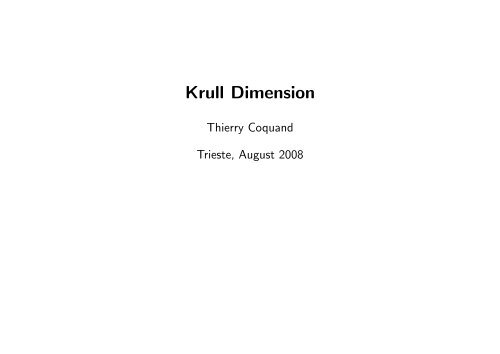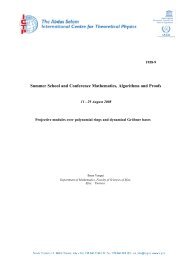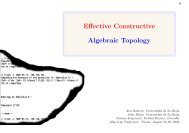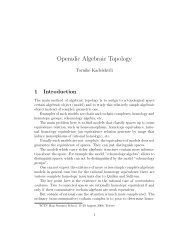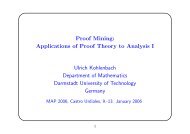Krull Dimension - CiteSeerX
Krull Dimension - CiteSeerX
Krull Dimension - CiteSeerX
Create successful ePaper yourself
Turn your PDF publications into a flip-book with our unique Google optimized e-Paper software.
<strong>Krull</strong> <strong>Dimension</strong><br />
Thierry Coquand<br />
Trieste, August 2008
<strong>Krull</strong> <strong>Dimension</strong><br />
References<br />
P. Johnstone Stone spaces, Cambridge University Press<br />
H. Lombardi, C. Quitté Algèbre Commutative, Modules projectifs de type fini,<br />
méthodes constructives, available from the home page of Henri Lombardi<br />
1
<strong>Krull</strong> <strong>Dimension</strong><br />
Zariski spectrum<br />
Any element of the Zariski lattice is of the form<br />
D(a1, . . . , an) = D(a1) ∨ · · · ∨ D(an)<br />
We have seen that D(a, b) = D(a + b) if D(ab) = 0<br />
In general we cannot write D(a1, . . . , an) as D(a) for one element a<br />
We can ask: what is the least number m such that any element of Zar(R)<br />
can be written on the form D(a1, . . . , am). An answer is given by the following<br />
version of Kronecker’s Theorem: this holds if Kdim R < m<br />
2
<strong>Krull</strong> <strong>Dimension</strong><br />
Boolean algebra<br />
A distributive lattice such that forall x there exists x ′ such that<br />
x ∨ x ′ = 1, x ∧ x ′ = 0<br />
x ′ is uniquely determined from this condition<br />
(x ∨ y) ′ = x ′ ∧ y ′ (x ∧ y) ′ = x ′ ∨ y ′<br />
3
<strong>Krull</strong> <strong>Dimension</strong><br />
<strong>Krull</strong> dimension of a ring<br />
The <strong>Krull</strong> dimension of a ring is defined to be the maximal length of proper<br />
chain of prime ideals.<br />
In fact, one can give a purely algebraic definition of the <strong>Krull</strong> dimension of a<br />
ring<br />
Inductive definition of dimension of spectral spaces/distributive lattice:<br />
Kdim X n iff for any compact open U we have Kdim Bd(U) < n (cf.<br />
Menger-Urysohn definition of dimension)<br />
To be zero-dimensional is to be a Boolean lattice<br />
4
<strong>Krull</strong> <strong>Dimension</strong><br />
iff<br />
<strong>Krull</strong> dimension of a lattice<br />
If L is a lattice, we say that u1, . . . , un and v1, . . . , vn are (n-)complementary<br />
u1 ∨ v1 = 1, u1 ∧ v1 u2 ∨ v2, . . . , un−1 ∧ vn−1 un ∨ vn, un ∧ vn = 0<br />
For n = 1: we get that u1 and v1 are complement<br />
Proposition: Kdim L < n iff any n-sequence of elements has a complementary<br />
sequence<br />
5
<strong>Krull</strong> <strong>Dimension</strong><br />
Logical complexity<br />
<strong>Krull</strong> dimension of a lattice<br />
Distributive lattice: equational theory<br />
The notion of complementary sequence is a first-order notion<br />
By contrast, the notion of increasing sequence of prime ideals is higher-order<br />
6
<strong>Krull</strong> <strong>Dimension</strong><br />
Complementary sequence<br />
If a1, a2 and b1, a2 have a complementary sequence then so have a1 ∨ b1, a2<br />
and a1 ∧ b1, a2<br />
If a1, a2 and a1, b2 have a complementary sequence then so have a1, a2 ∨ b2<br />
and a1, a2 ∧ b2<br />
In this way to ensure the existence of complementary sequence it is enough to<br />
look only at elements in a generating subset of the lattice<br />
7
<strong>Krull</strong> <strong>Dimension</strong><br />
<strong>Krull</strong> dimension of a ring<br />
Kdim R < n is defined as Kdim (Zar(R)) < n<br />
Proposition: Kdim R < n iff for any sequence a1, . . . , an in R there exists a<br />
sequence b1, . . . , bn in R such that, in Zar(R), we have<br />
D(a1, b1) = 1, D(a1b1) D(a2, b2), . . . , D(an−1bn−1) D(an, bn), D(anbn) = 0<br />
This is a first-order condition in the multi-sorted language of rings and lattices<br />
8
<strong>Krull</strong> <strong>Dimension</strong><br />
<strong>Krull</strong> dimension of a ring<br />
What does it mean for a ring to be 0 dimensional?<br />
For all x we have a relation x n (1 − ux) = 0<br />
If the ring is reduced (a nilpotent element is 0) this simplifies to<br />
∀x.∃u.x(1 − xu) = 0<br />
von Neumann regular ring<br />
9
<strong>Krull</strong> <strong>Dimension</strong><br />
<strong>Krull</strong> dimension of a ring<br />
Lemma: If R is a k-algebra and a1, . . . , al are algebraically dependent, i.e.<br />
there exists a relation P (a1, . . . , al) = 0 with P in k[X1, . . . , Xl] then a1, . . . , al<br />
has a complementary sequence<br />
Example for n = 2: we can assume the relation to be of the form<br />
a k2<br />
2 (ak1<br />
1 (1 + a1u1) + a2u2) = 0<br />
and we can take b2 = a k1<br />
1 (1 + a1u1) + a2u2 and b1 = 1 + a1u1<br />
10
<strong>Krull</strong> <strong>Dimension</strong><br />
<strong>Krull</strong> dimension of a ring<br />
Corollary: If k is a field then Kdim k[X1, . . . , Xn] < n + 1<br />
Indeed n + 1 elements are always algebraically dependent<br />
11
<strong>Krull</strong> <strong>Dimension</strong><br />
Kronecker in section 10 of<br />
Example: Kronecker’s theorem<br />
Grundzüge einer arithmetischen Theorie der algebraischen Grössen<br />
J. reine angew. Math. 92, 1-123 (1882)<br />
proves a theorem which is now stated in the following way<br />
An algebraic variety in C n is the intersection of n + 1 hypersurfaces<br />
12
<strong>Krull</strong> <strong>Dimension</strong><br />
Kronecker’s Theorem<br />
Theorem: If Kdim R < n then for any b0, b1, . . . , bn there exist a1, . . . , an<br />
such that D(b0, . . . , bn) = D(a1, . . . , an)<br />
It says that if Kdim R < n then we can write any elements of the Zariski<br />
lattice on the form D(a1, . . . , an)<br />
Corollary: If Kdim R < n then any element of Zar(R) can be written as the<br />
union of at most n basic open D(a)<br />
This is a (non Noetherian) generalisation of Kronecker’s Theorem<br />
13
<strong>Krull</strong> <strong>Dimension</strong><br />
Kronecker’s Theorem<br />
In particular if R is a polynomial ring k[X1, . . . , Xl] then this says that given<br />
finitely many polynomials we can find l + 1 polynomials that have the same set<br />
of zeros (in an algebraic closure of k)<br />
14
<strong>Krull</strong> <strong>Dimension</strong><br />
Kronecker’s Theorem<br />
This concrete proof/algorithm, is extracted from R. Heitmann “Generating<br />
non-Noetherian modules efficiently” Michigan Math. J. 31 (1984), 167-180<br />
Though the use of prime ideals, topological arguments on the Zariski spectrum,<br />
this paper contains implicitely a clever and simple algorithm which can be<br />
instantiated for polynomial rings<br />
15
<strong>Krull</strong> <strong>Dimension</strong><br />
Kronecker’s Theorem<br />
Kronecker’s Theorem is direct from the existence of complementary sequence<br />
Lemma: If X, Y are complementary sequence then for any element a we have<br />
D(a, X) = D(X − aY )<br />
Since we have D(a, X − aY ) = D(a, X) it is enough to show D(a) <br />
D(X − aY )<br />
D(x1 − ay1, x2 − ay2) = D(x1 − ay1, x2, ay2) since D(x2y2) = 0<br />
D(x1 − ay1, x2, y2) = D(x1, ay1, x2, y2) D(a) since D(x1y1) D(x2, y2)<br />
16
<strong>Krull</strong> <strong>Dimension</strong><br />
Computer algebra<br />
An experiment (from C. Quitté, in Magma) about computing complementary<br />
sequences<br />
f0, f1, f2, f3 are<br />
x 2 1 − x1, x1x3 − 2x2 + 2x 2 3, 2x1 + x2, − 5x1x2 − 3x 2 2 − 3x2x 2 3 + 2x3<br />
17
<strong>Krull</strong> <strong>Dimension</strong><br />
g3 is<br />
Computer algebra<br />
25/191x 2 1x 2 2 +30/191x1x 3 2 +30/191x1x 2 2x 2 3 −20/191x1x2x3 −275/382x1x2 +<br />
9/191x 4 2 + 18/191x 3 2x 2 3 + 9/191x 2 2x 4 3 − 12/191x 2 2x3 − 165/382x 2 2 − 12/191x2x 3 3 −<br />
165/382x2x 2 3 + 4/191x 2 3 + 55/191x3 + 1<br />
g2, g1, g0 are too big to be shown on this slide<br />
18
<strong>Krull</strong> <strong>Dimension</strong><br />
Kronecker’s Theorem<br />
This was first proved by Kronecker using “difficult arguments from elimination<br />
theory” (Eisenbud). A general version for <strong>Krull</strong> dimension and Noetherian rings<br />
was discovered by van der Waerden about 1941.<br />
For rational polynomials, is the bound n + 1 optimal? In 1891, an example<br />
was thought to show this for n = 3, but the example turned out to be wrong<br />
(1941). Later it was shown by Kneser that for n = 3, only 3 polynomials are<br />
enough. For n, it was shown by Storch (1972) and Eisenbud-Evans that n is<br />
enough.<br />
19
<strong>Krull</strong> <strong>Dimension</strong><br />
Forster’s Theorem<br />
We say that a sequence s1, . . . , sl of elements of a commutative ring R is<br />
unimodular iff D(s1, . . . , sl) = 1 iff R = <br />
If M is a matrix over R we let ∆n(M) be the ideal generated by all the n × n<br />
minors of M<br />
Theorem: Let M be a matrix over a commutative ring R. If ∆n(M) = 1<br />
and Kdim R < n then there exists an unimodular combination of the column<br />
vectors of M<br />
This is a non Noetherian version of Forster’s 1964 Theorem<br />
20
<strong>Krull</strong> <strong>Dimension</strong><br />
Forster’s Theorem<br />
We get a first-order (constructive) proof.<br />
It can be interpreted as an algorithm which produces the unimodular<br />
combination.<br />
The motivation for this Theorem comes from differential geometry<br />
If we have a vector bundle over a space of dimension d and all the fibers are of<br />
dimension r then we can find d + r generators for the module of global sections<br />
21
<strong>Krull</strong> <strong>Dimension</strong><br />
Forster’s Theorem<br />
The proof relies on the following consequence of Cramer formulae<br />
Proposition: If P is a n × n matrix of determinant δ and of adjoint matrix<br />
˜P then we have D(δX − ˜ P Y ) D(P X − Y ) for arbitrary column vectors X, Y<br />
in R n×1<br />
Corollary: If P is a n × n matrix of determinant δ and X, ˜ P Y are<br />
complementary then D(δ) D(P (δX) − Y )<br />
22
<strong>Krull</strong> <strong>Dimension</strong><br />
Serre’s Spliting-Off Theorem<br />
This is the special case where the matrix is idempotent<br />
The existence of a unimodular combination of the column in this case has the<br />
following geometrical intuition.<br />
We have countinuous family of vector spaces over a base space. If the<br />
dimension of each fibers of a fibre bundle is > the dimension of the base space,<br />
one can find a non vanishing section<br />
This is not the case in general: Moebius strip, tangent bundle of S 2<br />
Vector bundles are represented as finitely generated projective modules<br />
23
<strong>Krull</strong> <strong>Dimension</strong><br />
Elimination of noetherian hypotheses<br />
Kronecker’s Theorem, Forster’s Theorem were first proved with the hypothesis<br />
that the ring R is noetherian<br />
The fact that we can eliminate this hypothesis is remarkable<br />
An example of a first-order statement for which we cannot eliminate this<br />
hypothesis is the Regular Element Theorem which says that if I = <br />
is “regular” (that is uI = 0 implies u = 0) then we can find a regular element in<br />
I.<br />
24


